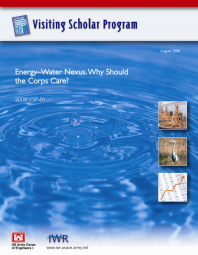
Energy-Water Nexus. Why Should the Corps Care?

Abstract
Water and energy are the two renewable resources that are most essential for human livelihood. Whereas we have been mostly concerned with non-renewable resources, as the human population grows in size and in terms of the impact that it has on the biosphere, the renewable resources become equally important. Even renewable resources may become limiting if the rate of their renewal is not fast enough. Renewal of water is dependent on energy. Production of energy, especially of renewable energy (biofuel and hydro), is dependent on water.
The water sector, including treatment and conveyance, is presently one of the largest users of energy, comparable to the paper and refining industries. Water acquisition, management, movement, distribution, purification and post-use treatment are large users of energy (Anderson, 1999). Water sector energy demand will likely substantially outpace growth in other high-energy use sectors. Water is similar to oil in that it is embedded in all human systems, even if it is not directly recognized as such. An average American consumes 7 times more water via the dietary food production (3997 liters/day– 1000 gal/day) than with all of the other daily domestic uses (Chapagain, Hoekstra, 2004).
By all accounts it seems unlikely that the current goal of providing additional supply for the growing water and energy demand will be sustainable and even feasible. We will have to focus on meeting our needs, rather than wants, in terms of both energy and water. As it will become increasingly hard to provide additional supply, we will need to pay attention to managing demand. By providing expertise and technology for integrated water management, as well as by discharging its regulatory missions, the Army Corps of Engineers is uniquely placed to recognize energy/water interactions and to contribute to demand reduction efforts.
Disclaimer
The contents of this paper are attributable to the author and not to the U.S. Army Corps of Engineers.
- Issues:
- Infrastructure, Energy, Natural Resources
- Region:
- North America
- Country:
- United States
- Year Published:
- 2008
- Author:
- Alexey Voinov
- Institution:
- US Army Engineers Institute for Water Resources (IWR)

